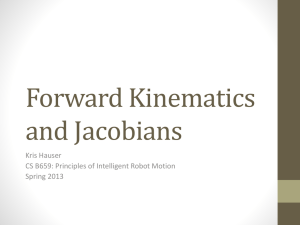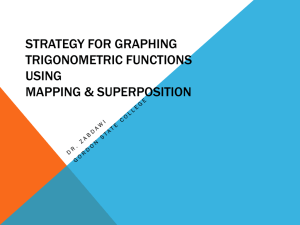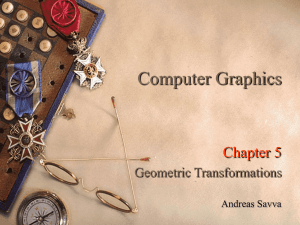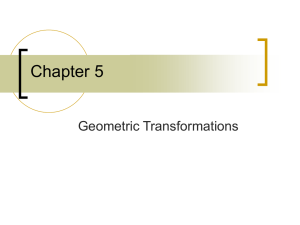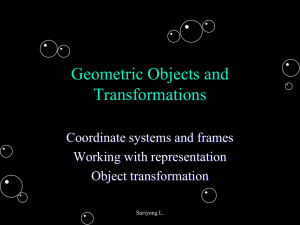Flash Animation Using Linear Transformations
advertisement
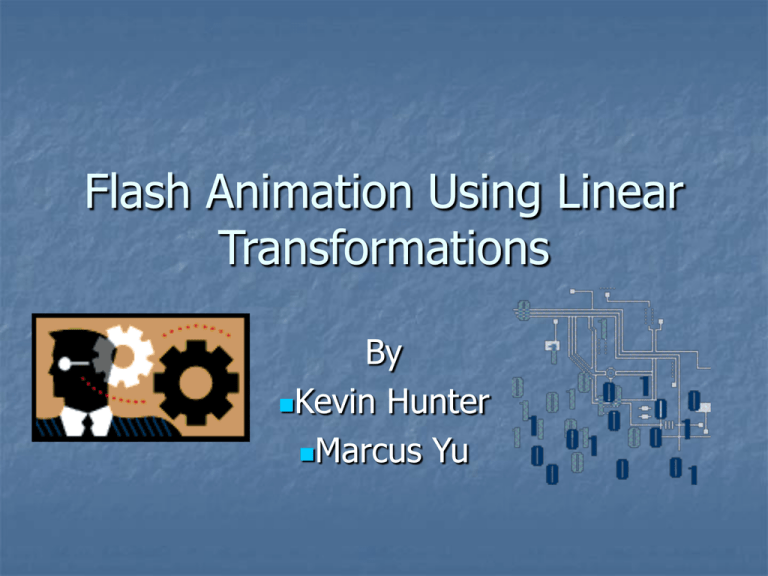
Flash Animation Using Linear Transformations By Kevin Hunter Marcus Yu Linear Transformations A transformation of matrix A from Rn Rm is called a linear transformation. Example: 1 0 A 2 1 3 4 1 0 1 1 Av 2 1 3 1 3 4 1 1 v 1 This shows that A transforms v into 1 w3 1 Translation Matrix 1 0 0 0 1 0 a b 1 Translation Designate an object to a square frame. Assign the translation matrix to correspond to a set point in the frame. Since nothing is being done to it yet, it will look like an identity matrix. Apply the translation to the matrix by adjusting the a and b value of the following matrix: The a value corresponds to the x value The b value corresponds to the y value 1 0 a 0 1 b 0 0 1 Application of Translation b a Any kind of picture inside this square frame Any kind of picture 0 square a v inside1this 0 1 b u frame 0 0 1 1 0 0 0 1 0 0 1 0 0 1 0 0 1 0 a 1 b 0 1 0 0 1 0 a b 1 Rotational Matrix cos sin 0 sin cos 0 0 0 1 Rotation Designate a point within the frame of the object to be the axis of rotation. Attach a vector from the point of rotation to the top left corner of the frame. Apply the rotation to the vector. How to calculate the rotation If we want to rotate the picture counter clock wise by 45o: Input 45 to the θ of the matrix: cos sin 0 sin cos 0 0 0 1 Application of Rotation θ 1 0 0 cos 0 1 0 sin 0 0 1 0 sin cos 0 0 cos 0 sin 1 0 sin cos 0 0 0 1 Combining Translation and Rotation θ b a cos sin 0 sin cos 0 a b 1 1 0 a cos 0 1 b sin 0 0 1 0 sin cos 0 0 cos 0 sin 1 0 sin cos 0 a b 1 Scaling Matrix x 0 0 0 0 y 0 0 1 Scaling Designate an object to a square frame. Since nothing is being done to it yet, it will look like an identity matrix. Apply the scaling to the matrix by adjusting the x and y value of the following matrix: The x value corresponds to the object’s x ratio size The y value corresponds to the object’s y ratio size x 0 0 0 0 y 0 0 1 Application of Scaling 1 0 a v 0 1 b u 0 0 1 1 0 0 1 0 a v 0 1 b u 0 0 1 0 1 0 0 1 0 0 1 0 0 2 0 0 1 0 0 1 0 0 2 0 0 0 1 Combining Translation, Rotation, and Scaling Translation & Scaling 1 0 0 x 0 a cos 0 1 0 0 y b sin 0 0 1 0 0 1 0 Original sin cos 0 Rotation 0 x cos 0 y sin 1 0 x sin y cos 0 Final Product of all 3 a b 1 Element of Time in Animation Animation is movement created through sequences of images linked together in a time frame. FPS: Frames per Second In order to create movement using matrices, you have to sequence increments of the translation and rotation within a set time frame. Divide the total translation and rotation into smaller pieces and place them into the appropriate frames. With a little help from Flash… Flash’s ActionScript language allows the matrices to be coded to automatically apply the desired transformation over a period of time. Coded properly, the computer ends up doing most of the calculations internally. Work in Progress! Work in Progress! The Final Product: The Final Product: THE END! :D




